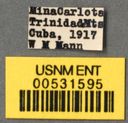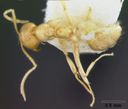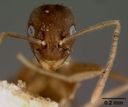False Honey Ants
Prenolepis
Classification
- Phylum: Arthropoda
- Subphylum: Hexapoda
- Class: Insecta
- Order: Hymenoptera
- Superfamily: Formicoidea
- Family: Formicidae
- Subfamily: Formicinae
- Tribe: Lasiini
- Genus: Prenolepis
Pronunciation
How to pronounce Prenolepis: //prɛˈnoʊlɪpɪs//
These audio files are automatically generated. While they are not always 100% accurate, they are a good starting point.
Images






Summary
Prenolepis imparis, known as the winter ant or false honey ant, is notable for its preference for cooler temperatures and unique hibernation behavior. It secretes a defensive liquid from its abdomen to protect against competitors.
Physical Characteristics
3-4 mm in size with triangular mandibles featuring 5 or 6 teeth (rarely 7); mesosoma has a distinctive hourglass shape, with a smooth and shiny dorsal surface.
Identification Tips
Look for the characteristic hourglass-like shape of the mesosoma and the triangular mandible when identifying this ant species.
Habitat
Nests deep within the ground, prefer cooler temperatures, including environments near freezing.
Distribution
Found throughout most of the United States, southern Ontario, and Mexico.
Diet
Primarily feeds on honeydew and other sugary substances, active for foraging primarily in winter and early spring.
Life Cycle
Enters a hibernation-like state called aestivation during the summer months.
Reproduction
Details on reproduction not provided in the source material.
Predators
Ants such as Linepithema humile, which can be deterred by the defensive secretions of Prenolepis imparis.
Ecosystem Role
Contributes to the ecological balance by controlling pest populations and serving as prey for other species.
Collecting Methods
- Ground sampling
- Digging into nests
Preservation Methods
- Preserving in alcohol
- Drying specimens
Misconceptions
Often mistakenly associated with true honey ants due to the common name 'false honey ant.'
Tags
- Ants
- Hymenoptera
- Prenolepis
- Insect
- North America